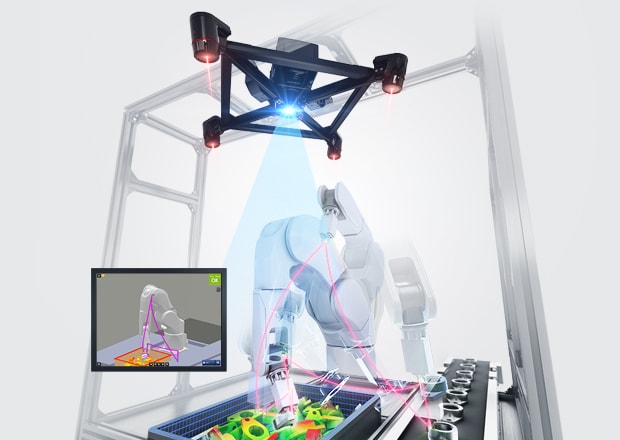Do’s and don’ts when implementing optical measurement system into legacy systems
Wiki Article
The Relevance of an Optical Measurement System in Industrial Applications
Optical measurement systems play an important duty in commercial applications. They offer high accuracy and assist in non-contact measurement, which is necessary for securing delicate components. These systems boost operational performance and advertise high quality control. Nonetheless, their execution is not without challenges. Understanding their relevance and the complexities included can illuminate their transformative possibility in contemporary production. What are the specific advantages and challenges that these systems present?Comprehending Optical Measurement Systems
Optical measurement systems play an essential duty in different commercial applications by offering exact and accurate information collection. These systems utilize light to gauge physical residential properties such as measurements, surface area accounts, and product attributes. The fundamental components usually include lasers, electronic cameras, and sensing units that capture and assess light shown from things. By utilizing strategies such as interferometry and photogrammetry, these systems can identify minute changes fit and size, which are crucial for quality assurance and product consistency.Furthermore, optical measurement systems are non-contact, allowing them to evaluate fragile or elaborate items without creating damages. They are functional, locating applications in fields like aerospace, automotive, and electronic devices manufacturing. The integration of sophisticated software for data evaluation boosts the functionality of these systems, making it possible for real-time monitoring and feedback. As markets evolve, the significance of optical measurement systems continues to expand, sustaining the demand for greater accuracy and performance.Trick Advantages of Optical Measurement in Manufacturing
While conventional measurement approaches usually involve physical get in touch with and can present mistakes, the fostering of optical measurement systems in making deals significant benefits. These systems use non-contact methods, decreasing the danger of damages to delicate elements and making sure the stability of measurements. Optical measurement offers high precision and accuracy, allowing suppliers to achieve tight tolerances essential in competitive markets.Additionally, the speed of optical measurement systems enhances performance. optical fibre diameter analyser. Fast data procurement enables real-time tracking, assisting in immediate changes in production processes. This effectiveness causes reduced waste and boosted resource allocation.Furthermore, the flexibility of optical systems fits a variety of products and geometries, making them ideal for different applications. Their ability to integrate effortlessly with automation innovations supports Sector 4.0 campaigns, advertising smarter making atmospheres. Generally, the crucial advantages of optical measurement contribute significantly to boosting top quality control and functional effectiveness in contemporary manufacturing settingsApplications of Optical Measurement Systems
Optical measurement systems play a crucial role in various commercial applications, particularly in enhancing accuracy throughout manufacturing processes. They are indispensable to quality control and assurance, ensuring that items satisfy strict standards. Additionally, these systems sustain study and growth initiatives by giving precise information for development and improvement.Precision in Manufacturing Processes
In modern-day production, high precision is necessary for making sure item quality and functional performance. Optical measurement systems offer innovative abilities that greatly boost precision during the manufacturing procedure. These systems use light and imaging modern technologies to record comprehensive measurements of elements, enabling producers to accomplish tight resistances and accurate dimensions. By incorporating optical measurement right into production operations, companies can promptly identify variances from specs, consequently decreasing waste and minimizing rework. The non-contact nature of optical dimensions allows for checking fragile or sensitive materials without threat of damages. Ultimately, the adoption of optical measurement systems cultivates a society of accuracy in production, resulting in improved performance and competitiveness in the industry.
Top Quality Control and Guarantee
Quality guarantee in making heavily counts on exact measurement strategies to ensure that items meet recognized requirements. Optical measurement systems play a pivotal duty in this procedure, allowing precise evaluations of measurements, surface area quality, and other essential features of produced items. By utilizing high-resolution imaging and innovative evaluation algorithms, these systems identify inconsistencies from specifications, guaranteeing uniformity throughout production. In addition, optical dimensions can be non-destructive, maintaining the stability of items while assisting in rapid assessments. The integration of these systems into quality assurance procedures improves effectiveness and decreases waste, eventually adding to improved item dependability. As industries venture for quality, the fostering of optical measurement innovations ends up being progressively important for maintaining affordable advantage and customer fulfillment.
R & D Applications
As sectors venture for advancement, optical measurement systems have become a crucial tool in research and advancement applications. fibre testing equipment. These innovative systems offer exact measurements of materials and components, allowing engineers and scientists to gain crucial understandings right into their buildings and performance. Optical measurement modern technologies, such as laser scanning and interferometry, promote the fast prototyping of brand-new layouts and the optimization of existing items. By capturing high-resolution data, scientists can determine flaws and evaluate the effect of various specifications on product capability. In addition, these systems support interdisciplinary cooperation, bridging spaces in between different fields. The combination of optical measurement systems into R&D refines ultimately increases development timelines and cultivates the production of sophisticated solutions in various industrial marketsComparing Optical Measurement to Conventional Techniques
In contrasting optical measurement systems to typical techniques, a number of essential elements emerge, including precision and precision. Additionally, the speed of measurement and cost-effectiveness play substantial duties in determining the suitability of each strategy for industrial applications. This examination highlights how developments in optical innovation may offer advantages over traditional methods.Precision and Precision
Optical measurement systems offer substantial benefits in precision and precision contrasted to traditional measurement methods. These systems utilize advanced innovation, such as lasers and high-resolution cameras, to capture dimensional data with very little error. In comparison, conventional methods often count on mechanical devices that can introduce irregularity because of human error or product wear. Optical systems can accomplish micrometer-level precision, guaranteeing constant results also in intricate geometries. Additionally, they offer non-contact measurement, decreasing the danger of damaging sensitive elements. This capacity is especially useful in industries where resistances are critical, such as aerospace and auto manufacturing. As a result, the adoption of optical measurement modern technology enhances quality assurance and reduces the chance of defects, eventually improving overall production performance.Rate of Measurement
The advantages of optical measurement systems prolong beyond accuracy and precision to consist of substantial renovations in measurement speed. Standard measurement approaches typically call for extensive fibre testing equipment arrangements and hands-on calculations, which can slow down manufacturing processes. On the other hand, optical systems utilize innovative innovations such as laser scanning and imaging, making it possible for fast information procurement and handling. This effectiveness permits real-time measurements, facilitating quicker decision-making in manufacturing environments. The capability to catch big volumes of information quickly boosts throughput and efficiency, offering companies an one-upmanship. Additionally, with minimized measurement times, optical systems lessen downtime linked with inspections, even more streamlining operations. Subsequently, the speed of measurement in optical systems substantially adds to general operational efficiency in commercial applications.Cost-Effectiveness Analysis
A complete cost-effectiveness analysis discloses that optical measurement systems usually offer considerable economic benefits over conventional techniques. These systems usually lower the requirement for considerable physical setups, minimizing labor expenses and downtime during measurement procedures. Optical approaches can likewise generate faster results, bring about raised productivity and decreased operational expenses. Additionally, the accuracy used by optical measurements decreases the possibility of pricey mistakes, which can develop from manual interventions and traditional techniques. Over time, the preliminary financial investment in optical modern technology is commonly balanced out by financial savings in resources, time, and boosted item high quality. Subsequently, markets that embrace optical measurement systems may discover themselves not just improving effectiveness however additionally achieving an extra positive cost-benefit ratio contrasted to standard approaches.
The Function of Automation in Optical Measurement
While several industries increasingly depend on accuracy and performance, automation has become an essential element in improving optical measurement processes. By integrating automated systems, companies can considerably boost measurement accuracy and decrease human mistake. Automated optical measurement systems make use of advanced formulas and sensors to give real-time data analysis, facilitating quicker decision-making and procedure adjustments.Additionally, automation permits for regular dimensions across different manufacturing runs, ensuring that top quality requirements are maintained. The scalability of automated optical measurement systems makes them suitable for diverse applications, from quality assurance in manufacturing to evaluation in semiconductor production.Furthermore, these systems can be flawlessly integrated into existing production arrangements, advertising a smooth shift towards much more efficient operations. Overall, the duty of automation in optical measurement is crucial, using improved integrity, reduced labor prices, and improved functional performance, eventually driving industrial competition.Challenges and Considerations in Implementation
Carrying out optical measurement systems, even with the advantages of automation, presents numerous challenges and considerations that organizations have to browse. One significant difficulty is the integration of these systems into existing process, which may call for substantial adjustments in processes and worker training. Organizations must likewise resolve the compatibility of optical measurement innovations with present tools and software.Additionally, the variability of products and environmental problems can influence measurement accuracy, demanding robust calibration and upkeep protocols. Expense is one more vital factor to consider, as preliminary investments can be significant, and companies should weigh these costs against potential effectiveness gains. Data monitoring also positions obstacles, as the quantity of info produced calls for efficient systems for storage space, analysis, and analysis. Making certain conformity with sector criteria and guidelines adds another layer of intricacy to the implementation procedure, requiring cautious planning and implementation.Future Fads in Optical Measurement Modern Technology
As industries remain to progress, improvements in optical measurement technology are readied to transform their operational landscapes. Arising fads suggest a shift towards boosted automation and assimilation with expert system, boosting the precision and efficiency of dimensions. Flexible optics is gaining traction, permitting systems to readjust in real-time to varying ecological conditions, therefore minimizing mistakes. Moreover, the miniaturization of optical sensing units is enabling their deployment in much more compact and diverse setups, expanding application opportunities in markets such as aerospace and manufacturing.Additionally, the growth of 3D optical measurement methods is changing high quality control procedures, supplying more considerable data analysis. Developments in information processing formulas are additionally expected to enhance the analysis of intricate dimensions, making understandings more available. Collectively, these trends mirror a future where optical measurement technology not only enhances accuracy however also boosts operational agility, positioning industries to better satisfy developing demands.Often Asked Questions
Just How Do Optical Measurement Systems Ensure Data Accuracy?
Optical measurement systems guarantee data accuracy through accurate calibration, progressed algorithms, and high-resolution imaging. These parts collaborate to reduce errors, boost measurement consistency, and supply trusted results vital for numerous industrial applications and processes.What Is the Normal Life-span of an Optical Measurement System?
The normal life-span of an optical measurement system varies, typically ranging from five to fifteen years. Variables affecting long life consist of usage strength, ecological conditions, maintenance practices, and technological innovations that might require upgrades or replacements.
Can Optical Measurement Systems Be Custom-made for Particular Industries?

What Training Is Needed for Running Optical Measurement Systems?
Training for operating optical measurement systems generally includes understanding system parts, software program usage, calibration techniques, information evaluation, and security procedures. Participants commonly take part in hands-on practice and might finish qualification courses to boost their proficiency.Exactly How Do Environmental Elements Influence Optical Measurement Results?
Ecological elements, such as temperature level, moisture, and lighting problems, significantly affect optical measurement results. Variants in these aspects can cause errors, influencing the precision and reliability of dimensions taken by optical systems in different settings.Report this wiki page